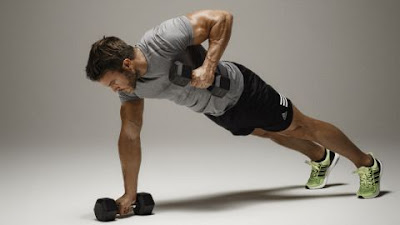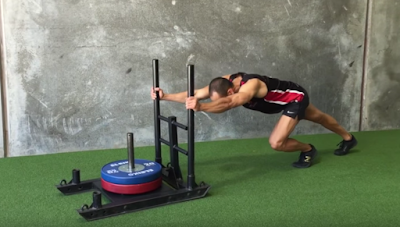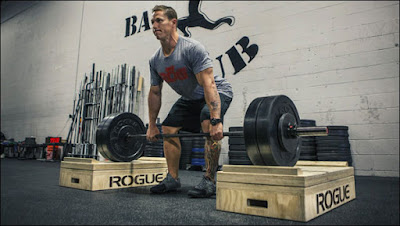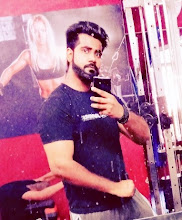Best Back Exercises
 |
| best back exercises |
These triumphant moves scarcely missed the cut last time around — and all are more than worth your time if your objective is a major, solid back.Four years prior, we set out on an overwhelming errand — positioning the 10 best activities for each major bodypart. From that point onward.
Positioning the best bodypart practices was a significant test. It included enthusiastic discussions from specialists and editors about each move that at last made — or didn't make — the rundown. Companionships were stressed, eye moving turned into an exercise all by itself, and once distributed, we heard bounty from our perusers who thought some about our decisions were, well, nuts. So you'd think we'd inhale a murmur of alleviation when it was said and done.
Post-production, however, we examined the notorious cutting-room floor and found an entire hell of a great deal of activities that were about as great — and, might we venture to state, maybe even apparently preferable — over those we highlighted the first run through around. Along these lines, we're beginning once more, and are currently conveying the "following best" 10 activities for each muscle gathering, opening again with back. The entirety of the accompanying moves merit thought when arranging your preparation routine, and ought to be mixed with the first 10 activities for a fair program. All things considered, for proceeded with progress, assortment is critical. On that point, there's unquestionably no contention.
1: Renegade Row:-
Muscles Focused on: lats, rhomboids, teres major and minor, infraspinatus, erector spinae
Working out perfectionists would laugh at the consideration of this utilitarian development, and if bulk is your unparalleled objective, there are absolutely better activities from which to pick. In any case, with regards to creating synergistic body quality and all out body control, the maverick column conveys, calling intensely on your center for adjustment and your nonworking muscles for isometric quality while you push with the other arm. It's a superb finisher, and you additionally can space it in as a warm-up or an auxiliary move after an episode of overwhelming free weight or hand weight lines.
Step by step instructions to: Position two free weights parallel on the floor and get into a push-up position with your hands on the free weights and your legs spread wide. Your head, hips and heels ought to adjust, center tight, head impartial. Line one hand weight up to your flank, driving your elbow skyward while keeping your hips level and your head nonpartisan. Lower gradually to the floor and keep, exchanging sides for reps.
 |
| Renegade Row |
2: Kipping Pull-Up:-
Muscles Focused on: lats, midback, center
In article after article, we lecture "immaculate structure": Don't swing your body, don't utilize energy, don't swindle. So for what reason would we put this disputable CrossFit staple on our rundown? Here, a little force can mean significantly more reps — and with regards to building up your back, the more draw up reps you can log, the better.
Kipping is obtained from sports, for example, tumbling or hand to hand fighting, and is an ability wherein you make upward push by utilizing your bodyweight to create energy. This lessens the contribution of the arms, empowering you to do much a bigger number of reps than you could if utilizing ultra-exacting structure while additionally avoiding the littler biceps muscles from turning into a restricting element. It likewise depends on an unstable compression of your lats and mid-and upper-back muscles, enough so it lands unequivocally here on this rundown.
The most effective method to: Take an overhand hold on a draw up bar and accept a dead hang — arms completely expanded, legs straight, feet off the floor. Keep your legs tight together as you swing them behind you, at the same time driving your chest forward and your head between your arms. At that point swing your legs forward, contract your abs and snap your hips upward as you drive your elbows down and back to lift your jaw over the bar. Keep quickly then drop down to the beginning. Work toward building up a mood to associate redundancies.
 |
| Kipping Pull-Up |
3: Bent-Over Smith Machine Row:-
Muscles Focused on: lats, rhomboids, teres major and minor, infraspinatus
A few people despise the Smith machine, regularly to Bieber-esque levels. Web trolls pummel it for securing you in an exacting all over plane of development, which is unnatural with regards to most activities, and they bring up that the offset will in general make practices excessively simple by lessening the requirement for settling muscle movement.
These supposed drawbacks of the Smith might be a weakness for certain activities — the squat starts things out to mind — however a line isn't among them. Nonetheless, the Smith push shouldn't be your solitary paddling exercise; it ought to be put something aside for later in the session when your auxiliary muscles might be progressively worn out and needing a little help.
Step by step instructions to: Remain with your feet shoulder-width separated with the fronts of your lower legs flush with the bar. In the event that the bar doesn't go sufficiently low, remain on a stage. Take an overhand hold on the bar simply outside your lower legs with your center tight, back level, head unbiased. Unlatch the safeguards by curving the bar, at that point maneuver it into your upper stomach area or lower chest, driving up with your elbows and crushing your shoulder bones together at the top. Lower the bar along a similar way to the beginning.
 |
| Bent-Over Smith Machine Row |
4: Sled Pull:-
Muscles Focused on: lats, rhomboids, traps, teres major and minor, infraspinatus, erector spinae
Envision contending in a back-and-forth as a feature of your back exercise and you'll comprehend the advantage of adding the sled dismantle to your program. This mechanical assembly and the pulling development selects all the key back muscles associated with a column, however with an invite portion of assortment, regardless of whether as a warm-up, midworkout challenge or a finisher.
"What I like about the sled is that you can pull substantial loads and develop muscle continuance," says Gerren Liles, a ReebokOne diplomat and Equinox ace teacher situated in New York City. "What's more, in light of the fact that the unconventional remaining task at hand is insignificant when utilizing a sled versus an increasingly commonplace weighted exercise, you'll likely experience less irritation. That implies you can go super-hard without stressing that it'll influence your up and coming exercises."
Step by step instructions to: Secure a rope to the front of a stacked sled. Position the sled toward one side of an open region, stretch the rope toward the opposite side and remain there with your feet shoulder-width separated. Grasp the rope with two hands, drop your hips and curve your knees, keeping your abs tight. Keep up this situation as you pull the sled toward you, hand over hand, until it arrives at your toes. At that point loosen up the rope again and rehash for the length of the territory.
 |
| sled pull |
5: Landmine Barbell One-Arm Row:-
Muscles Focused on: rhomboids, lats, teres major and minor, infraspinatus, levator scapulae, trapezius
One-arm free weight columns came in No. 4 on our unique top-10 rundown, and this variety measures up for similar reasons: It straightforwardly rebuffs the muscles of the center and upper back, and on the grounds that you work each side autonomously, a more grounded side can't make up for a more fragile one, as can occur with a two-gave hand weight push.
Other than the one-sided benefits, the point of force is somewhat adjusted with this variant, since the weight isn't before your grasp rather than similarly adjusted around your hand likewise with a free weight. These little changes enlist an alternate scope of muscle strands, making this an unquestionable requirement add supplement to a standard line.
The most effective method to: Secure one finish of a free weight in a landmine and burden the far edge. Remain close by the stacked end and twist at the hips until your middle is at a 45-degree point to the floor, back level and head impartial. Handle the bar with the nearest hand either toward the end (appeared) or where the pole meets the neckline to lift it from the floor. Drive your elbow up and back to bring the bar toward your flank as high as you can without bending. Lower along a similar way, however don't give the plates a chance to contact down between reps. Do all reps on one side before exchanging arms.
 |
| Landmine Barbell One-Arm Row |
6: Supported Row:-
Muscles Focused on: lats, rhomboids, traps, teres major and minor, infraspinatus
While the hand weight Ski lift push made our unique rundown, this variety merits a detect all its own. "The help enables you to confine and concentrate on the back, rather than standing, where your leg quality and situating — just as your center — will assume a job in your exertion," Liles says. "Despite the fact that it displays the way of movement, it considers a free-weight feel." A line, for example, this should be possible with hand weights, iron weights or singularly for assortment.
One drawback: Lying on a help cushion packs the stomach, which makes it somewhat harder to inhale profoundly when dealing with substantial loads. All things considered, the upheld push is as yet amazing for moderate-weight, higher-rep conventions — an unadulterated, basic column that legitimately focuses on the center back.
Step by step instructions to: Set a grade seat to a low edge, around 30 degrees. Falsehood facedown on the seat with your chest and shoulders bolstered, feet on either side, and hold a hand weight in a shoulder-width overhand grasp. Keeping your back level and your head impartial, drive your elbows up and back while sliding your shoulder bones internal. Hold quickly at the top at that point lower gradually to the beginning. Note: Don't enable your chest area to lift off the cushion with an end goal to pull the weight upward, since this puts undue weight on the low back.
 |
| supported row |
7: Seated Good Morning:-
Muscles Focused on: erector spinae
On the off chance that you care about your squat and deadlift sums — and you should — think about this variety of the customary great morning as your new clear-cut advantage. It works the center and lower back — quite the erector spinae, which are key for balancing out the spine — enabling you to deal with more weight when pulling a hand weight from the floor or coming up out of the opening during a squat.
The customary standing hand weight great morning approaches an overwhelming portion of hamstrings and glutes to control the movement. Be that as it may, by sitting down, those lower-body muscles are de-stressed, enabling you to concentrate more on the lower back. This move is likewise better than a back expansion on a 45-or 90-degree seat, which gets the hip flexors included and makes it very simple to hyperextend your back, lifting your middle past level and setting superfluous weight on the spinal circles.
The most effective method to: Spot a seat (or box) inside a power rack and set a hand weight at your typical squat level. Position the free weight over your shoulders and upper back — as in a squat — and step back to clear the backings. Gradually sit on the seat and spread your legs with your feet level on the floor for soundness. Keeping your back level and your center tight, twist forward from the hips, bringing down the extent that you can until your chest or external flank contacts the upper within your legs (if conceivable), and halting before your lower back rounds. Turn around the movement to come upstanding. At the point when you've finished your reps, stand and rack the bar.
 |
| seated good morning |
8: Clean Pull Off the Rack:-
Muscles Focused on: lats, rhomboids, traps, teres major and minor, infraspinatus, erector spinae
This development is a go-to among Olympic lifters and powerlifters preparing to build their deadlift aggregates. In numerous regards, it's a deadlift that starts from a higher position, decreasing the attention on the glutes and hamstrings and actuating a greater amount of the mid-and upper back. It likewise includes touchy components and a shrug toward the end, bringing the snares into play.
"By doing a progressively touchy deadlift you can work with fitting load for higher reps, expanding the general tonnage of your exercise, which is useful for quality and hypertrophy," says Heather Rancher, a New York-based fitness coach, wellness mentor, CrossFit bunch class teacher and top-five broadly positioned Olympic weightlifting contender. "Likewise, individuals are commonly more grounded from mid-pull than they are off the floor, and those with portability limitations that reason their back to adjust when pulling from the floor ought to be more secure at this higher beginning position."
Step by step instructions to: Set the free weight at or simply under knee level in a power rack and remain with your feet hip-width separated and the bar leaning flush against your shins. Handle the bar outside your legs and lift your hips so they are only higher than your knees, abs tight and back level. Broaden your legs and hips violently, pulling the bar up along your quads as you come upstanding, and finish the rep with a commanding shrug at the top. Lower the bar along a similar way, enable it to choose the snares, at that point rehash.
 |
| Clean Pull Off the Rack |
9: Pendlay Row:-
Muscles Focused on: lats, rhomboids, traps, teres major and minor, infraspinatus, erector spinae
During a normal free weight push, the plates never contact the floor during the set, keeping pressure on the objective muscles all through. Not so with the Pendlay push, a move named after USA Weightlifting trainer and previous contender Glenn Pendlay — yet in the event that picking up quality is your game, this change is certainly for the better.Setting the free weight on the floor toward the finish of every rep diminishes the time your lower back needs to help the full weight of a stacked bar, offering those muscles a little reprieve and enabling you to work up to heavier lifts. That dead stop likewise enables you to reset yourself so your structure doesn't stray, as will in general occur at the finish of a troublesome arrangement of standard hand weight lines.
The most effective method to: Remain with your feet shoulder-width separated and the fronts of your lower legs flush with the free weight. Twist down and take an overhand hold simply outside your lower legs on the bar, at that point lift your hips so your back is parallel to the floor, center and hamstrings enacted and lower back angling normally. Keeping your middle enduring, maneuver the bar dangerously into your upper belly, driving upward with your elbows and pressing your shoulder bones together at the top. Lower the bar along a similar way and let it settle to the floor quickly as you prepared for the following rep.
 |
| pendlay row |
10: Snatch-Grip Deadlift:-
Muscles Focused on: lats, rhomboids, traps, teres major and minor, infraspinatus, erector spinae
There might be no cleaner articulation of solidarity than the deadlift. It requires an unpredictable exhibit of muscle bunches working pair to pull a substantial item from the floor (which is the reason it ruled No. 1 as our preferred utilitarian exercise ever in our December 2016 issue.) The grab hold deadlift, similar to the spotless draw, is a minor departure from the conventional. "It's great for back advancement to a great extent since it connects with the whole upper back significantly in excess of a traditional deadlift," Rancher says.
To capitalize on it, center around a couple of key pointers. "Hold the lower back tight and angled — abstain from adjusting no matter what," Rancher cautions. "What's more, the hold itself ought to be wide, with your hands set on or outside the knurling on the free weight. You likewise need to pass through your legs, wrapping the lift with your chest up."
Instructions to: Remain with your feet hip-width separated, toes underneath the hand weight and shins flush against the bar. Hunch down and take a wide, past shoulder-width grasp on the hand weight. With a level back, lift your hips so they are higher than your knees, support your center and haul the leeway out of the bar. Broaden your legs and hips at a similar rate and drag the bar up along your shins and thighs until you come to standing. Drop down along a similar way until the plates contact the floor, giving it a chance to settle quickly before beginning the following rep.
 |
| Snatch-Grip Deadlift |





Good
ReplyDeleteBest Online Casino - Bracketeering the Winning Numbers
ReplyDeleteThe first three casinos to get legal 블랙잭 gambling 넷마블 토토 사이트 in the USA are: 카지노사이트 · Las Atlantis 카지노777 and The Venetian · Caesars What is the minimum age to play at casinos?What 룰렛 배팅 are the minimum payouts for casinos?